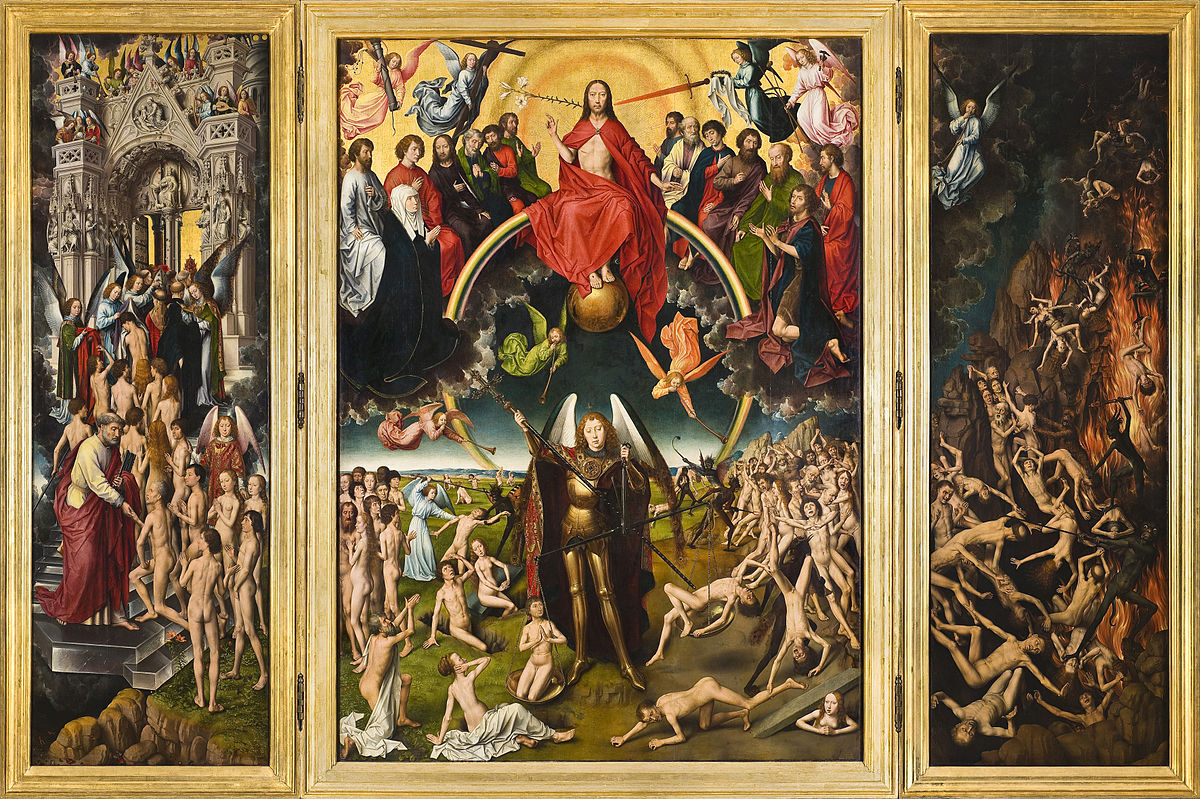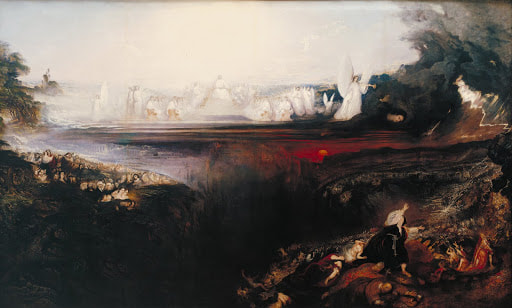|
by Saffron Sener Hans Memling, Last Judgment, triptych, oil on wood, 1466-1473 One of the most prominent (and my personal favorite) scenes in Northern European 14th to 16th century art is that of the ‘Last Judgment’. A Biblical story derived from the more apocalyptic portions of the text, the narrative of the ‘Last Judgment’ or ‘The Day of the Lord’ decrees that following Christ’s Second coming, all on Earth will face evaluation at the hands of God. Each person will be determined “good” or “bad”, and from this judgment be sent to Heaven, Purgatory, or Hell. Look to Pieter Bruegel’s 1558 engraving or the ‘Last Judgment’ half of Jan van Eyck’s diptych for examples of the gothic, dark, moody Northern depictive style. Perfectly odd, grotesque, dark, excessively detailed, and absolutely amazing. This isn’t to say that Lower Europe, specifically Italy, France, and Spain, failed to pay attention to this cataclysmic unfolding. Michelangelo’s mid-1500s Last Judgment pays a sunny, heaven-centric homage to the scene. Fra Angelico’s 1431 interpretation is similar to that of a triptych, with Jesus Christ floating above the rest on a throne of gold. La Gloria by Titian in 1554 is a perspectivally-unique, communicative piece that forces the viewer to look upward towards the glory that was Heaven. The divide between the two regions, as it often is, lays within their respective bright or dark natures, in the gaudiness of one versus the brutality of other, their overall styles as according to the sort of period eye (as Michael Baxandall would say) of either place. We can see collective attention placed on narrative across Europe, with a transition from Heaven to Hell often occurring from up to down or left to right, centered by Mary or Jesus Christ. We can also see an adherence to the concepts of the story, with a clear divide and communication of good/bad between Heaven and Hell maintained in both the North and South. However, in the interest of speaking to one Northern European artist’s rendition of the Last Judgment rather than drawing a developed comparison and contrast between the scene’s treatment in the North and South, I’ll point this towards Hans Memling. Born in the 1430s, Hans Memling hailed from the Middle Rhine region. Little is known of his early life beyond his apprenticeship in Mainz or Cologne and subsequent training under Rogier van der Weyden in Brussels. This is where Memling integrated himself in the Netherlandish art scene. By 1465, he was a citizen of Bruges in Flanders. In 1477, he married a woman named Anne and fathered several children. Successful in his career and popular with Italian patrons, Memling enjoyed relative wealth via his artistic endeavors for the duration of his lifetime. He died in 1495. Typically, despite his Germanic background, he is grouped into the Early Netherlandish tradition and movement due to his location throughout the majority of his life as well as stylistic dealings with perspective and spiritual/mythical narratives. The Last Judgment by Memling is one of the artist’s most-well known. A triptych displaying the entrance into Heaven, judgment by Christ, and descent into Hell respectively from left to right, this piece affixes the Biblical narrative into one - a framework of an almost mythical majesty. About ten feet by seven feet, this looming artwork overpowers its audience in its intense grappling with the apocalypse of life on Earth. On the far left is the first panel, which depicts the ascent of those deemed “good” into Heaven. Saint Peter helps the naked, white bodies of the saved onto the silvery, almost crystal stairs that snake up to the entrance of paradise. Immediately in front of the gate, a group of angels clothe the people in deep-hued dresses similar to their own. The gate itself, surrounded by a stormy wreath of clouds, is in a Gothic architectural style and is adorned with reliefs sat in attendance of those entering. Balconies carved into the passage hold angels in bright clothes and with bright wings playing a litany of instruments. If one looks closely, they can see that the Pope and other high-ranking Church officials are leading the procession into paradise; further analyzing the identities of those supposed worthy in the eyes of the Lord, one may notice the seemingly special facial features, implying their potential representation of patrons to Memling. On the central panel, one can see the beginning of this judgment narrative develop. Seated on a rainbow and draped in a red cape, Jesus Christ stares directly at the viewer. His feet - crucifixion wounds on display - rest on a golden orb. Out of his right side grows a flower (a lily) while a red-hot sword points inward at his left. Behind him is a golden light that appears to emanate outward from his body. Kneeling on the same stormy clouds that surround Heaven are the twelve apostles, who extend in placement behind the son of God. At the end of either line of apostles is Mary, who looks to her son, and John the Baptist, who looks to the audience. Above them all, in the upper corners of the panel, are four angels holding the Instruments of Passion (which Jesus utilized to overcome Satan): a column, representing where Jesus was flagellated, the cross where he was crucified, his crown of thorns, and the Holy Lance driven into his side. Below this floats three angels blowing the horns of the apocalypse point inward at Saint Michael. His figure, as well as the rainbow upon which Jesus rests, separates the realms of Heaven and Hell in the location of the Last Judgment, the valley of Josaphat. On his right, there extends far into the background green grasslands, where people are rising from their graves, angels are fighting with demons over individual souls, and the line into paradise begins. On his left, on the dead, brown land crowds of people are being driven backward by the dark, smoky bodies of demons. Saint Michael stands tall above this, using a balance to determine the goodness or badness of an individual. He wears reflective gold armor, a red cape embellished with designs, and a pair of creamy-black wings that flow into that of a peacock. Using his crosier, the Saint jabs any person tipping towards evil and expels them to Hell. Moving to the final panel, one can see the realities of Hell as imagined by Memling. Grotesque, animalistic bodies with tails, taloned feet, and somewhat dog-like faces torture the souls damned to this realm. Their black bodies represent a hybrid between human and creature, juxtaposed upon the writhing, white bodies of the humans sent to Hell. Fires lick upwards in the backdrop of this panel, with flying demons carrying loads of souls into their reaches, almost like they were kindling. Every face of the damned displays an acute sense of suffering, and most gaze away (potentially in shame) or keep their eyes closed. Notice the disjointed amount of people on the two side panels; far more people were sent to Hell than granted passage into Paradise. Above this scene of torture floats the final angel of the trio in the central panel, blowing the last trumpet of the apocalypse. This piece is gripping, intense, and weird. I love it. In a similar strange, whimsical, fashion is Hieronymus Bosch’s 1482 work of the same name. In both, Jesus Christ sits upon a rainbow ring flanked by the pristine glory of Heaven on the left and the everlasting fires and monstrous demons of Hell on the right. The Lord reigns above a land of naked people and brightly clothed angels, running about during a catastrophic sorting of good and bad and medium. For both Bosch and Memling, the story of the Last Judgment provide a narrative by which the limits of illusionism, curiosity, and symbols are explorable. It’s not often that I, as a student of art history, get to just jump into something distinctly in my interests. I find the classes on the Renaissance abounding, courses about contemporary art a constant availability. And that’s not necessarily a bad thing (though I will contend that Art History, on the whole, is a very Western, very White, very elite field). It’s not a great or good thing either, though. I understand that my now extensive experience with Italian art through its ages has helped build the analysis you just read. But I also understand that this analysis is flawed, incomplete, rooted in a knowledge that is almost entirely self-researched and self-taught. Where the institution has failed me, though, I must grow -- it has and is on me to put the extra effort in to explore what I love and what traditional art history tries so hard to hide (I’m coming for you, Picasso and Pollock). To completely conclude this treatise on ‘The Day of the Lord’, Hans Memling, and the strange darkness of Northern Renaissance art, I would like to acknowledge a somewhat more contemporary rendition of the Biblical scene that may or may not be my personal favorite to date. John Martin’s 1853 Last Judgment is wispy, expansive, and quietly captivating. Unified by an endlessly deep void and flowing in a varied, asymmetrical way, this piece is, in my opinion, breathtaking. Noticeably, the perspective is that of someone above Christ and the unfolding of the apocalypse, rather than some positioned below the hierarchy of Heaven and Hell. John Martin, Last Judgment, oil paint on canvas, 1854
4 Comments
Jesse Rico
8/25/2021 01:38:05 pm
There was no analysis on jesus hand gestures
Reply
chooper
3/2/2022 01:30:02 pm
As above, so below
Reply
5/23/2022 12:58:03 pm
Nepal is safe country to travel the Nepal. There are local people to supporting the tourist, and talk with the friendly. Our Travel Tourist guider expert shares the tourist advice to safe places. You want to travel the Nepal Contact Travels2Nepal .
Reply
Leave a Reply. |
Archives
March 2024
Writers
All
|

